|
Obsolete Outboards |

|
|
by Max Wawrzyniak - St Louis, Missouri - USA
Onboard Spares 'n Tools
|
 |
People who know that I run 1950's outboard motors often ask me
what onboard spare parts and tools I carry.
(Actually, nobody ever asks, but the marketing experts tell me
that if I say others are interested, then you might be interested too.)
|
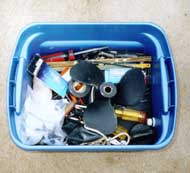 This is the tool and spares "kit" that I carry onboard the AF4.
Everything fits inside a plastic container that is kept underneath
the spashwell at the stern. This particular container makes better
use of the space available than a typical tool box would. This is the tool and spares "kit" that I carry onboard the AF4.
Everything fits inside a plastic container that is kept underneath
the spashwell at the stern. This particular container makes better
use of the space available than a typical tool box would.
(click images for larger views) |
|
The tools and spares that I carry aboard a boat will vary depending upon
the circustances. For example, if I am at a messabout based out of
a campground, where cruises will be short and in the immediate area,
I see little need to carry other than maybe a spare shear pin or two
(see propellers column) along with the tools necessary to install them.
Usually, a large pair of pliers will remove the cotter pin and propeller nut,
although an adjustable wrench might be kinder on the "flats" of a threaded
prop nut. With other boats involved in the group nearby, there is little
chance of a breakdown leaving one in dire straits. The 14 foot 1956
aluminum Crestliner boat that I take to antique outboard motor meets
usually represents this level of preparedness. You can be sure that
I will have tools and maybe some spares in my pickup truck, but I
will carry little in the boat on the short 10 or 15 minutes excursions
that are the usual activites at these meets. I might also carry a spare
propeller, but that is about it.
| One can fit quite a bit of crap into these plastic containers |
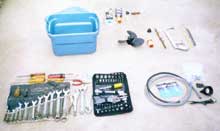
|
|
Those familar with the function of a shear pin (see propellers column, again)
might question the necessity of carrying a spare propeller, but as someone
who has had the rubber cushioned hub of a propeller fail, allowing the blades
to spin freely on the hub, I think it wise to carry the prop. Having (2) props also
allows one to have both "speed" (high pitch) and "power" (low pitch) props
to use with different loads.
The other extreme of preparedness is when one is traveling long distances through remote
areas or without the company of other boats. In these circumstances,
more tools and spares are called for, and I generally keep my AF4
cabin skiff stocked to this level of preparedness. I have a full set
of wrenches and sockets, several screwdrivers; regular, "needle-nose,"
and locking (Vicegrip) pliers and a few other misc. tools.
|
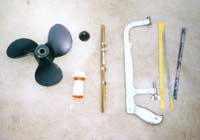 Spare propeller and propeller nut, with shear pins and cotter
pins in the pill jar. In the center of the photo are several lengths
of brass rod of varying diameters. The hacksaw can be used to
cut shear pins of any length needed from the brass rods. Since I
often run different engines, the rods and saw allow me to custom-cut
a shear pin for just about any old OMC outboard. If you have but
a single engine, all you need to carry is a few pins that will fit
your engine. Note the worm-screw hose clamps binding the rods
together; it is sometimes handy to have a few extra camps onboard. Spare propeller and propeller nut, with shear pins and cotter
pins in the pill jar. In the center of the photo are several lengths
of brass rod of varying diameters. The hacksaw can be used to
cut shear pins of any length needed from the brass rods. Since I
often run different engines, the rods and saw allow me to custom-cut
a shear pin for just about any old OMC outboard. If you have but
a single engine, all you need to carry is a few pins that will fit
your engine. Note the worm-screw hose clamps binding the rods
together; it is sometimes handy to have a few extra camps onboard.
|
|
I suppose that I should point out that the tools carried should be
in SAE (Society of Automotive Engineers) "inch" sizes and not
metric.
Spare parts kept aboard the AF4 consist of a propeller, propeller nut,
cotter pins, shear pins, a couple of sparkplugs, a few short lengths of
different size fuel hose and a couple of spare "in-line" fuel filters, and
a water pump impeller. One advantage of the older OMC engines is
the interchangebility of some replacement parts; for example, the pump
impeller that I carry fits both the 1957 Johnson 18 hp that I usually run on
the AF4, along with the 1956 Johnson 10 that I use on the boat on
lakes with 10 hp limits. The spark plugs also fit both of those engines
and also the 1955 Johnson 5 1/2 hp engine that serves as an auxilary
engine. The pump impeller, however, will not fit the 5 1/2.
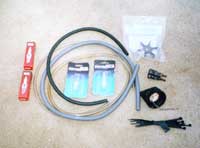 A couple of spark plugs, some fuel hose in different diameters, a pair of "in-line" fuel filters (which I use on all of my old outboards), and a waterpump impeller. Also shown is a spare cap for a pressuriezed remote fuel tank (the tank isn't going to hold pressure if you lose the cap overboard) along with a spare hose quick connector for a pressure tank. The wire ties sometimes come in handy for "jury-rigged" repairs. A couple of spark plugs, some fuel hose in different diameters, a pair of "in-line" fuel filters (which I use on all of my old outboards), and a waterpump impeller. Also shown is a spare cap for a pressuriezed remote fuel tank (the tank isn't going to hold pressure if you lose the cap overboard) along with a spare hose quick connector for a pressure tank. The wire ties sometimes come in handy for "jury-rigged" repairs. |
|
That 5 1/2 is sort of a "spare" as well. I have never had to
use the spare engine to get to where I was going
but I still like to carry it on the AF4, which is fitted with a lifting
bracket for it. The 5 1/2, featured in the first "Start to Finish" series of
columns, replaced a 3 hp that really did not have the power to handle
the AF4 in wind or current. Also, the main engines use pressureized
remote fuel tanks (see pressure tank column) as does the 5 1/2, whereas
the 3 hp used an engine- mounted, gravity-fed fuel tank that required me to
carry a small portable gas can for refueling it. The 5 1/2 can be run
with the main tanks.
|
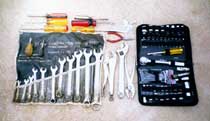 A cheap set of "combination" (open-end and box-end) wrenches, screwdrivers in both regular and phillips types, with several sizes of each, and a small set of socket wrenches. Pliers in "regular," locking, and needle-nose varieties, and an adjustable (Crescent) wrench. That's a set of "feeler" gauges next to the needle-nose pliers, for setting spark plug gaps and ignition point gaps. A cheap set of "combination" (open-end and box-end) wrenches, screwdrivers in both regular and phillips types, with several sizes of each, and a small set of socket wrenches. Pliers in "regular," locking, and needle-nose varieties, and an adjustable (Crescent) wrench. That's a set of "feeler" gauges next to the needle-nose pliers, for setting spark plug gaps and ignition point gaps.
|
|
The Crestliner is not set-up for a spare engine, but then I rarely travel far
from "home base" in that boat I always carry a paddle in both boats,
and last spring I used the paddle in the Crestliner to good advantage
when I "blew-up" the 1940 Johnson I was running that day. I was
upwind of the dock and not too far out and managed to "sail" back
to the marina using the paddle to steer and to control leeway.
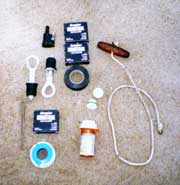 Misc. items: spare boat plugs in the (2) different sizes used on my AF4: extra batteries (AA size) for the little flashlights that I have onboard, a starter rope to be used if the recoil starter on an outboard fails, electrical tape, teflon plumbers tape (used to seal the threads on the cheap plastic garboard drain plugs I installed on the AF4), and a pill bottle containing some spare hardware for the bimini top. Misc. items: spare boat plugs in the (2) different sizes used on my AF4: extra batteries (AA size) for the little flashlights that I have onboard, a starter rope to be used if the recoil starter on an outboard fails, electrical tape, teflon plumbers tape (used to seal the threads on the cheap plastic garboard drain plugs I installed on the AF4), and a pill bottle containing some spare hardware for the bimini top. |
|
As previously mentioned, most of the engines I run use pressureized
remote fuel tanks, and each tank has it's own fuel hose permanently
mounted. Remote tanks for outboards equiped with fuel pumps often
have a quick connector at both the outboard and also on the remote
tank, allowing one fuel hose to be used with two or more tanks. I will not
leave the dock for all but the shortest cruises in the friendliest of waters
without at least (2) fuel hoses on board, even if I only have
one remote tank. The fuel hose assembly is easy to damage, especially
the primer bulb of fuel hoses for fuel pump-equiped engines. I have had
"O" rings in quick conenctors tear, destroying the seal and preventing the
fuel pump from drawing fuel from the tank. Countless rubber fuel hoses
have been cut by bouncing tackle boxes, deck chairs, and other gear.
Since the hoses are permanently clamped to pressure tanks, I prefer to
carry (2) small tanks rather than one big tank, which not only provides
redundent hoses but also redundant tanks, as old pressure tanks, inherently
more complicated than fuel pump tanks, are a bit more prone to problems.
|
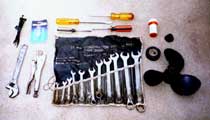 My suggested tool kit for anyone running a 1950's/ 1960's OMC outboard: a set of combination wrenches, an adjustable wrench, locking pliers, (2) different sizes of both regular and phillips screwdrivers, electrical tape, spare fuel filter (if your engine uses one, and it should), and spare prop., prop nut, shear pins and cotter pins. My suggested tool kit for anyone running a 1950's/ 1960's OMC outboard: a set of combination wrenches, an adjustable wrench, locking pliers, (2) different sizes of both regular and phillips screwdrivers, electrical tape, spare fuel filter (if your engine uses one, and it should), and spare prop., prop nut, shear pins and cotter pins.
|
|
A word about spark plug fouling, where the inner end of the spark plug
becomes so caked with carbon and other crap that it doesn't spark
any more, and the engine doesn't run any more. Decades ago, this
was a common problem with outboards. Fouled plugs rarely occur
today, as modern 2-cycle oils burn very cleanly and leave few deposits
behind. I have not fouled a spark plug since 1994, although I do make
a habit of replacing the plugs every year or two, whether they need to be
replaced or not. It is still a good idea to carry spare plugs, however, on
the longer trips. Although a fouled plug can be removed from the engine,
cleaned, and reinstalled, one would be suprised by the number of
cleaned plugs that accidentally end up dropped into the deep.
| The ultimate spare; a complete second engine. Of course, it adds weight, takes up space, and is an added expense. |
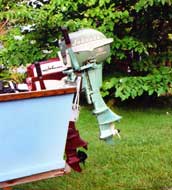
|
|
A final note: A person who has resurrected an old outboard purchased
at a garage sale or flea market will have an advantage
on the water if and when trouble occurs over a person who has never
cleaned the carburetor or replaced the fuel lines or adjusted the points on
his outboard. Being familar with your engine can eliminate much of the mystery
of dealing with engine problems on the water.
A little practical mechancal experience can be the most usefull
"tool" one can possess on a boat.

click here for a list of Columns by Max Wawrzyniak
|